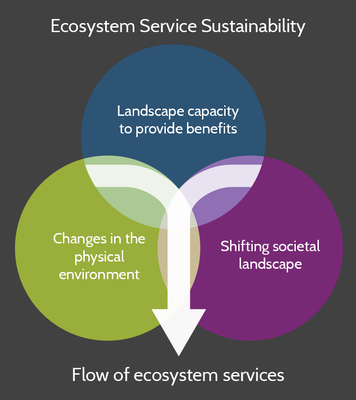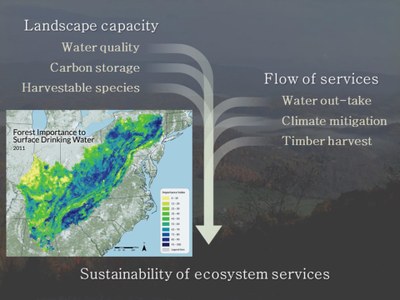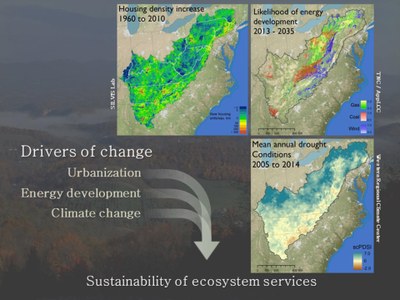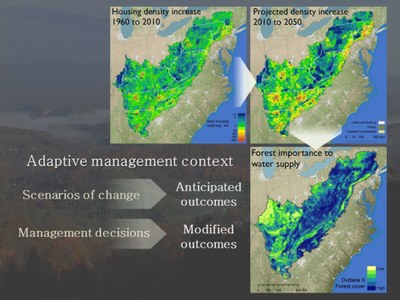An ecosystem services research framework

The Appalachian LCC is collaborating with scientists at the US Forest Service’s Eastern Forest Environmental Threat Assessment Center to assess the sustainability of the region’s highly valued ecosystem services, and their vulnerability to the rapid environmental changes that the region is undergoing. The research team is utilizing a range of approaches for this assessment; here we describe a framework for undertaking this work.
The Appalachian region encompasses a rich diversity of forests, streams, and other natural resources that provide important benefits, referred to as ecosystem services, to millions of people. These benefits are as diverse as clean water, forest products, outdoor recreation and tourism, fish and wildlife conservation, and the recycling and storage of carbon and nutrients. The region is also the scene of rapid environmental change. Drivers behind this change include processes such as urbanization, energy resource development, and climate change, as well as large-scale disruptions associated with wildland fire, forest insect and disease outbreaks, and invasive species. There is increasing concern that these drivers of landscape change may compromise the sustainability of ecosystem services over the long term.
Using existing data to develop measures of vulnerability and resilience
 Vulnerability assessment is an important tool for understanding landscape change. The goal is to measure, and map, the supply of ecosystem services provided by landscapes and the flow of these services to increasing human populations. Understanding the sustainability of these flows also requires measuring the impact of key drivers of landscape change, such as urbanization processes, on the natural resources that provide the basis for ecosystem services.
Vulnerability assessment is an important tool for understanding landscape change. The goal is to measure, and map, the supply of ecosystem services provided by landscapes and the flow of these services to increasing human populations. Understanding the sustainability of these flows also requires measuring the impact of key drivers of landscape change, such as urbanization processes, on the natural resources that provide the basis for ecosystem services.
In this way, we can gauge possible future changes in the flow of ecosystem services, given realistic expectations of landscape change. This requires understanding how sensitive a service such as clean water production is to different kinds of landscape change. Vulnerability assessment uses large data sets to build models that describe these relationships.
We are developing vulnerability assessments at the scale of the entire Appalachian LCC. Comprehensive assessments that include the impacts of multiple drivers of change are challenging, especially across a region as large and diverse as the Appalachians. It is impractical or even impossible to measure the responses of all ecosystem services to all drivers of change.
 Nonetheless, in the age of ‘big data’, numerous geographic data sets are available to measure past changes in the environment and the societal landscape, as well as models which describe likely future changes. Some of these data products represent key aspects of land and water use and climate variability. Similarly, data products representing ecosystem services, or reliable proxies for them, are available. These may include measures of forest timber productivity, surface water yield, carbon stocks, and landscape naturalness indices, among others.
Nonetheless, in the age of ‘big data’, numerous geographic data sets are available to measure past changes in the environment and the societal landscape, as well as models which describe likely future changes. Some of these data products represent key aspects of land and water use and climate variability. Similarly, data products representing ecosystem services, or reliable proxies for them, are available. These may include measures of forest timber productivity, surface water yield, carbon stocks, and landscape naturalness indices, among others.
Our plan is twofold. On one hand, we are developing vulnerability assessments for a small number of key services as a first step towards providing partners with useful new understandings of ecosystem service vulnerabilities and options for enhancing their sustainability. On the other hand, we are developing more integrative measures which we expect to provide a holistic understanding of the capacity of landscapes to support a diversity of ecosystem services. While these measures may not provide specific information on any one resource, they may be more able to detect the resilience of ecosystems to various kinds of resource use and landscape change. The quantitative measures being developed are thus indices of landscape resilience, and they should relate crucially to resource sustainability. These measures complement, rather than replace, approaches focused on single resources, providing maps of the capacities of different kinds of landscapes to support nature-based needs and values over the long term.
Connecting assessments with resource management and conservation
 Ultimately, assessment efforts are only useful when they are valued by resource management and conservation stakeholders as a tool for improving sustainability. The goal of the assessment process is to produce tangible measures of change over time, which can help to weigh adaptive management options in a landscape context. Vulnerability assessment and quantitative measures of landscape resilience result in compelling, LCC-wide maps and data products that describe linkages between drivers of landscape change and the sustainability of ecosystem services.
Ultimately, assessment efforts are only useful when they are valued by resource management and conservation stakeholders as a tool for improving sustainability. The goal of the assessment process is to produce tangible measures of change over time, which can help to weigh adaptive management options in a landscape context. Vulnerability assessment and quantitative measures of landscape resilience result in compelling, LCC-wide maps and data products that describe linkages between drivers of landscape change and the sustainability of ecosystem services.
These linkages provide a foundation for understanding the continuing ability of Appalachian landscapes to provide benefits to people, under different management, policy, and development scenarios. Such understanding helps managers, scientists, industries, and the public establish a common language for linking the environmental and economic values of the region’s natural assets in a way that encourages protection of and investments in these resources.





















